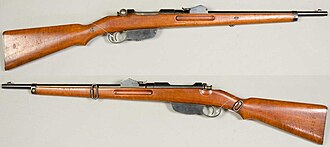| Repeating carbine model 1890 | |
|---|---|
 Model 1890 cavalry carbine, from the collections of the Swedish Army Museum | |
| Type | Bolt action rifle |
| Place of origin | Austria-Hungary |
| Service history | |
| In service | 1890–1918 (Austria-Hungary) |
| Used by | See users |
| Wars | Balkan Wars World War I |
| Production history | |
| Designer | Ferdinand Mannlicher |
| Designed | 1890? |
| Manufacturer | Österreichische Waffenfabriksgesellschaft |
| Produced | 1891–1896 |
| No. built | 115,218 |
| Variants | Cavalry carbine, Gendarmerie carbine and Navy short rifle |
| Specifications | |
| Mass | 3.3 kilograms (7.3 lb) |
| Length | 1,005 millimetres (39.6 in) |
| Barrel length | 498 millimetres (19.6 in) |
| Cartridge | M90: 8×52mmR [1] M90/24:8×57mm IS M90/30, M90/31: 8×56mmR |
| Action | Straight-pull bolt action |
| Muzzle velocity | 620 m/s (2,034 ft/s) with M1893 ball cartridge [2] |
| Feed system | 5-round en bloc clip, integral box magazine |
| Sights | Iron sights |
The repeating carbine model 1890 a.k.a. Mannlicher model 1890 carbine is a bolt-action rifle, designed by Ferdinand Mannlicher that used a new version of his straight-pull action bolt. [3] It was introduced as an alternative to the Mannlicher M1888 as it was shorter and easier to maneuver with. Three main versions were introduced: Cavalry Carbine, Gendarmerie Carbine [1] and Navy Short Rifle.

